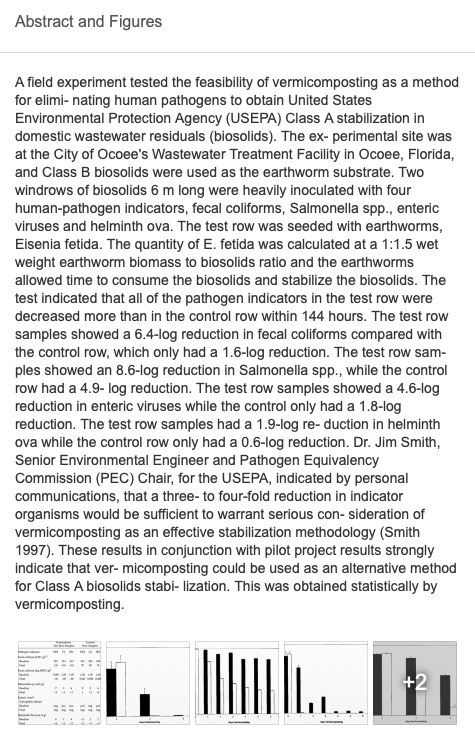The Effectiveness of Vermiculture in Human Pathogen Reduction for USEPA Biosolids Stabilization
Author: Eastman, B. R., Kane, P. N., Edwards, C. A., Trytek, L., Gunadi, B., Stermer, A. L., Mobley, J. R.
Year: 2001
Publisher: Compost Science & Utilization
A field experiment tested the feasibility of vermicomposting as a method for elimi- nating human pathogens to obtain United States Environmental Protection Agency (USEPA) Class A stabilization in domestic wastewater residuals (biosolids). The experimental site was at the City of Ocoee’s Wastewater Treatment Facility in Ocoee, Florida, and Class B biosolids were used as the earthworm substrate. Two windrows of biosolids 6 m long were heavily inoculated with four human-pathogen indicators, fecal coliforms, Salmonella spp., enteric viruses and helminth ova. The test row was seeded with earthworms, Eisenia fetida. The quantity of E. fetida was calculated at a 1:1.5 wet weight earthworm biomass to biosolids ratio and the earthworms allowed time to consume the biosolids and stabilize the biosolids. The test indicated that all of the pathogen indicators in the test row were decreased more than in the control row within 144 hours. The test row samples showed a 6.4-log reduction in fecal coliforms compared with the control row, which only had a 1.6-log reduction. The test row sam- ples showed an 8.6-log reduction in Salmonella spp., while the control row had a 4.9- log reduction. The test row samples showed a 4.6-log reduction in enteric viruses while the control only had a 1.8-log reduction. The test row samples had a 1.9-log re- duction in helminth ova while the control row only had a 0.6-log reduction. Dr. Jim Smith, Senior Environmental Engineer and Pathogen Equivalency Commission (PEC) Chair, for the USEPA, indicated by personal communications, that a three- to four-fold reduction in indicator organisms would be sufficient to warrant serious con- sideration of vermicomposting as an effective stabilization methodology (Smith 1997). These results in conjunction with pilot project results strongly indicate that ver- micomposting could be used as an alternative method for Class A biosolids stabi- lization. This was obtained statistically by vermicomposting.
The Effectiveness of Vermiculture in Human Pathogen Reduction for USEPA Biosolids Stabilization
External Link
Open linkWould you like to see other resources here?
Give us your feedback"*" indicates required fields
Still have questions?
You could not find the information you were looking for? Please contact our helpdesk team of experts for direct and individual support.


